Key takeaways:
- Abstract Expressionism emphasizes emotional and psychological exploration through spontaneous and non-traditional artistic techniques.
- The movement emerged in the late 1940s and 1950s, reflecting post-war sentiments and significant cultural shifts in the United States.
- Key artists like Jackson Pollock, Willem de Kooning, and Mark Rothko employed innovative methods to convey complex emotions and challenge traditional art forms.
- The creative process in Abstract Expressionism values vulnerability, community, and patience, allowing artists to explore their inner landscapes and respond to the world around them.
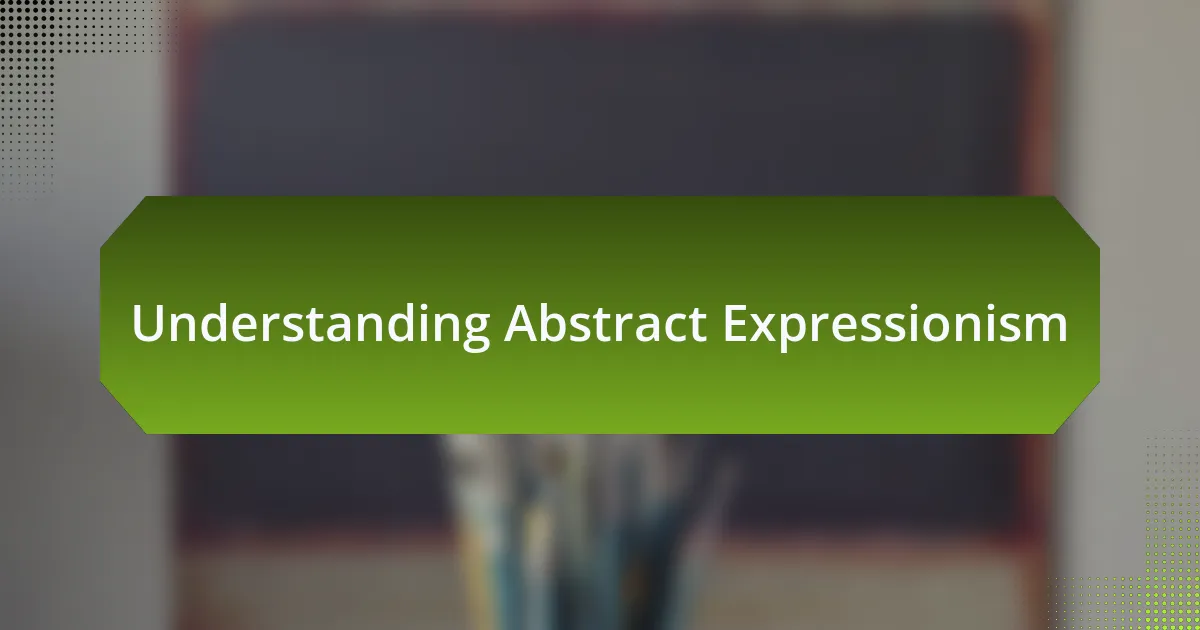
Understanding Abstract Expressionism
Abstract Expressionism is a movement that goes beyond mere aesthetics; it’s a form of emotional and psychological exploration. I remember standing in front of a Mark Rothko painting and feeling a rush of emotions—his bold color fields seemed to resonate with an inner turmoil that I couldn’t quite articulate. It made me wonder, how can a canvas provoke such depth of feeling?
At its core, Abstract Expressionism champions spontaneity and the act of creation. I often think back to my attempts at abstract painting; each brushstroke felt liberating, yet there was a vulnerability in exposing my raw emotions to the world. Isn’t it fascinating how these works often reflect the artist’s psyche more than any representational artwork could?
This art form challenges traditional notions of beauty and form, inviting viewers to engage with the chaos and energy that come from the subconscious. For me, encountering a Jackson Pollock piece for the first time felt like diving into a whirlpool of thoughts and feelings, a reminder that art doesn’t always have to conform. Isn’t that what makes Abstract Expressionism so compelling? The unpredictable dance of color and shape becomes a window into the artist’s innermost thoughts.
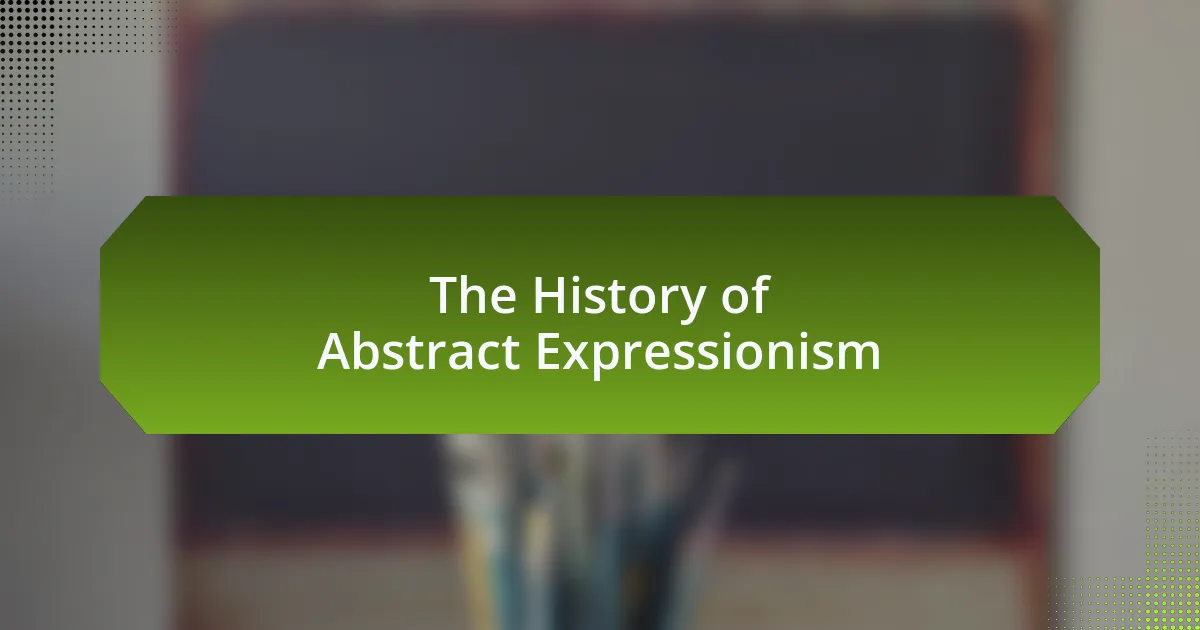
The History of Abstract Expressionism
The Abstract Expressionism movement emerged in the United States in the late 1940s and 1950s, marking a pivotal shift in the art world. I recall my first encounter with an exhibition dedicated to this genre, where I felt a palpable energy coursing through the air. It was as if the chaotic brushstrokes and splashes of color were whispering the collective angst and aspirations of a generation grappling with the aftermath of war.
Artists like Jackson Pollock and Willem de Kooning sought to break free from traditional artistic constraints. I remember discussing Pollock’s drip paintings with a friend, who pointed out how they challenged the very definition of painting itself. This radical freedom in expression reflected the artists’ desire to externalize their inner turmoil, prompting me to consider: can art be not just a reflection but also a catalyst for emotional release?
The movement also paralleled significant cultural shifts, as American artists began to gain recognition on the global stage. I find it fascinating that this blossoming occurred during a time of social upheaval and existential questioning. How much did this context fuel the urgent emotions expressed on canvas? To me, it seems that every brushstroke was a response to the complex web of individual and collective experiences, making Abstract Expressionism an enduring testament to the human condition.
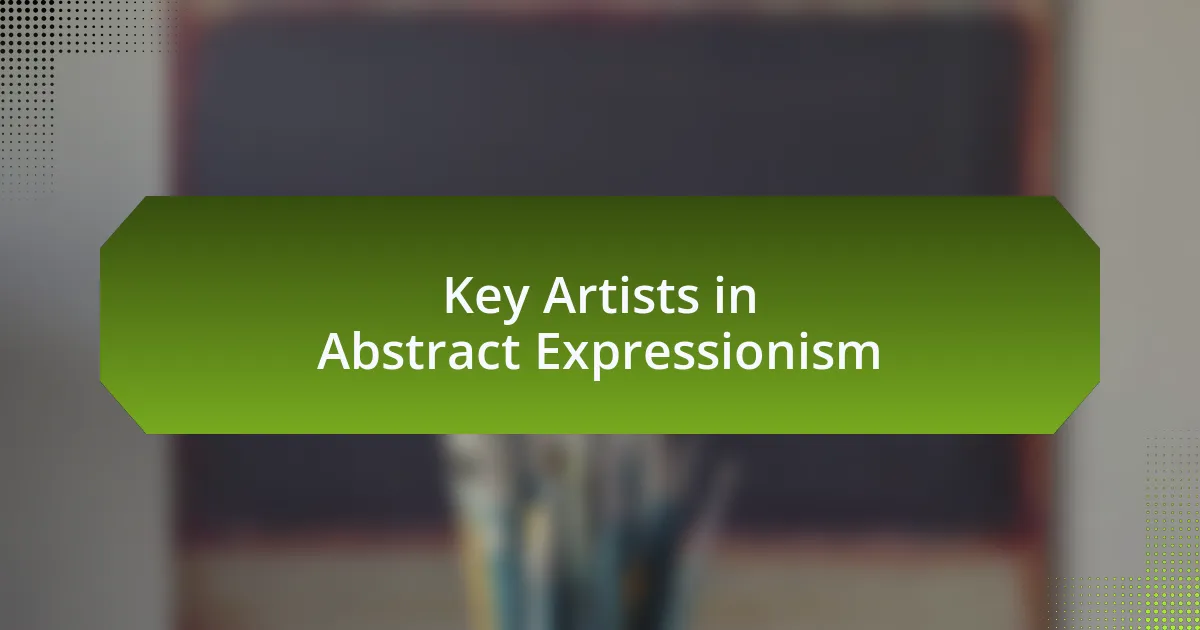
Key Artists in Abstract Expressionism
When talking about key artists in Abstract Expressionism, Jackson Pollock undoubtedly stands out. His innovative drip technique fascinated me the first time I saw one of his paintings in person; the way paint seemed to dance on the canvas made me ponder the connection between movement and emotion. What struck me most was how this method allowed him to convey spontaneity, turning each piece into a dynamic interplay of chaos and control.
Willem de Kooning is another pivotal figure whose work resonates with me. His Women series boldly challenged conventional forms and representations of femininity. I remember discussing these pieces with fellow art lovers and reflecting on how de Kooning’s aggressive brushwork might mirror societal tensions of the time. Could his depiction of women be seen as a commentary on both admiration and fear? For me, this layered complexity invites an ongoing conversation about gender and identity in art.
Lastly, I can’t overlook Mark Rothko, whose color field paintings evoke profound emotional experiences. Standing before one of his large canvases was almost meditative, as the blocks of color seemed to draw me into a deeper state of reflection. This feeling brings to mind a question: what is it about color that can so powerfully affect our mood and thoughts? Rothko’s ability to create such emotional landscapes ultimately reminds us of the universal language of art.
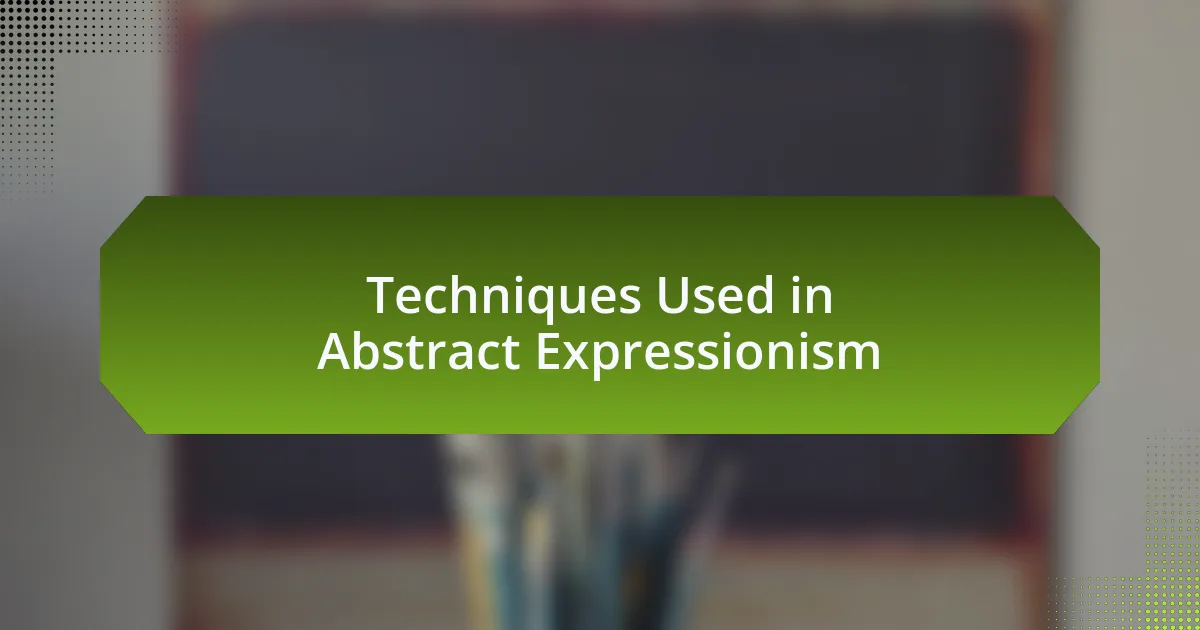
Techniques Used in Abstract Expressionism
Abstract Expressionism is characterized by its emphasis on spontaneous, automatic, or subconscious creation. One technique that often captivates me is action painting, where the artist applies paint to the canvas in dynamic, vigorous gestures. I remember the first time I witnessed an artist engaging in this method—it felt like watching a dance unfold, with each brushstroke a testament to their emotional state at that moment.
Another remarkable technique is color field painting, utilized by artists such as Rothko. This approach focuses on large areas of color, which can evoke strong emotional reactions. When I stood in front of a Rothko piece, I felt enveloped by the colors themselves, as though they were speaking directly to me. How can mere colors conjure such depth of feeling and introspection?
Additionally, the use of non-traditional materials and tools adds an intriguing layer to this movement. Artists often utilized brushes, but some opted for palette knives, sponges, or even their hands to manipulate paint. I recall visiting an exhibit where an artist used sand and gravel in their work, creating texture that drew me in and made me consider the relationship between art and the physical world. Does using unconventional materials challenge our perceptions of what art can be? For me, it certainly expands the dialogue about creative expression.
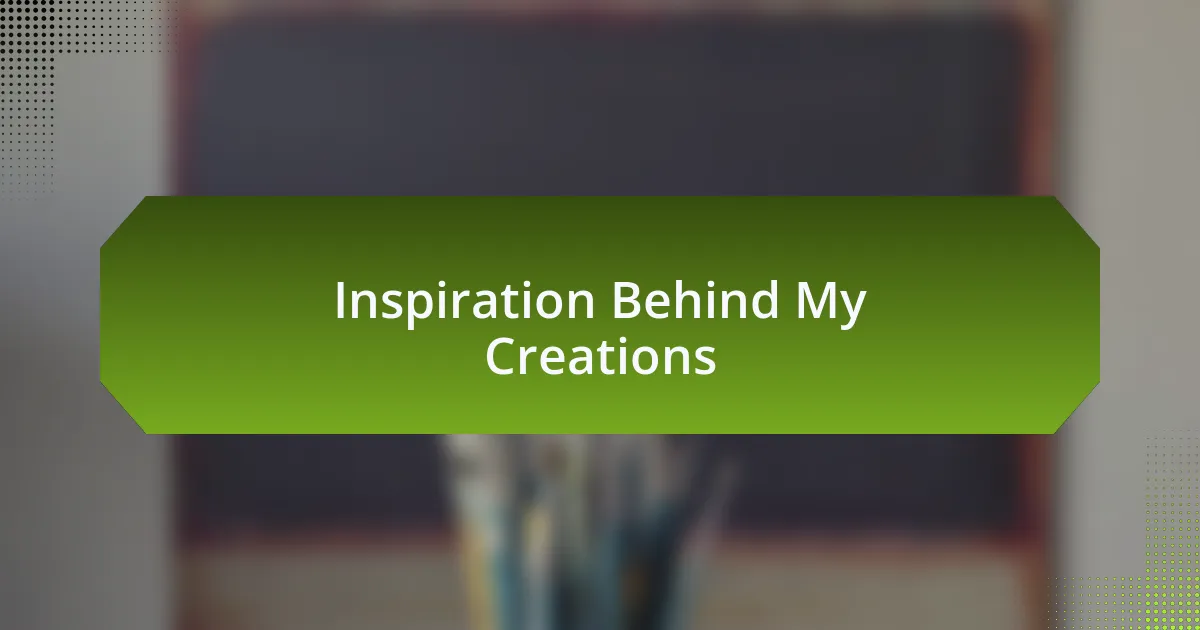
Inspiration Behind My Creations
Creating my abstract expressionist pieces is deeply rooted in my personal experiences and emotions. I draw inspiration from the chaotic beauty of everyday life. For instance, one afternoon, while sitting in a bustling café, I became captivated by the blend of conversations and sounds around me. The interaction of voices, laughter, and even fleeting silence sparked a desire to translate that dynamic energy onto canvas.
Nature also plays a significant role in shaping my work. I often find myself reflecting on a memorable hike where the splashes of color from autumn leaves seemed almost otherworldly. The way those hues danced with the light stirred something profound within me. It made me wonder: Can nature’s beauty evoke the same feelings we experience in our inner worlds?
Moreover, I embrace the unpredictability of my creative process. Each session in my studio feels like a conversation with the canvas, where I let my intuition guide my hand. I vividly recall a time when I accidentally spilled paint, and instead of feeling frustrated, I leaned into it, letting the unexpected inspire new forms. Isn’t it fascinating how mistakes can lead us to new discoveries? Each creation is, for me, an exploration of both my internal landscape and the world around me.
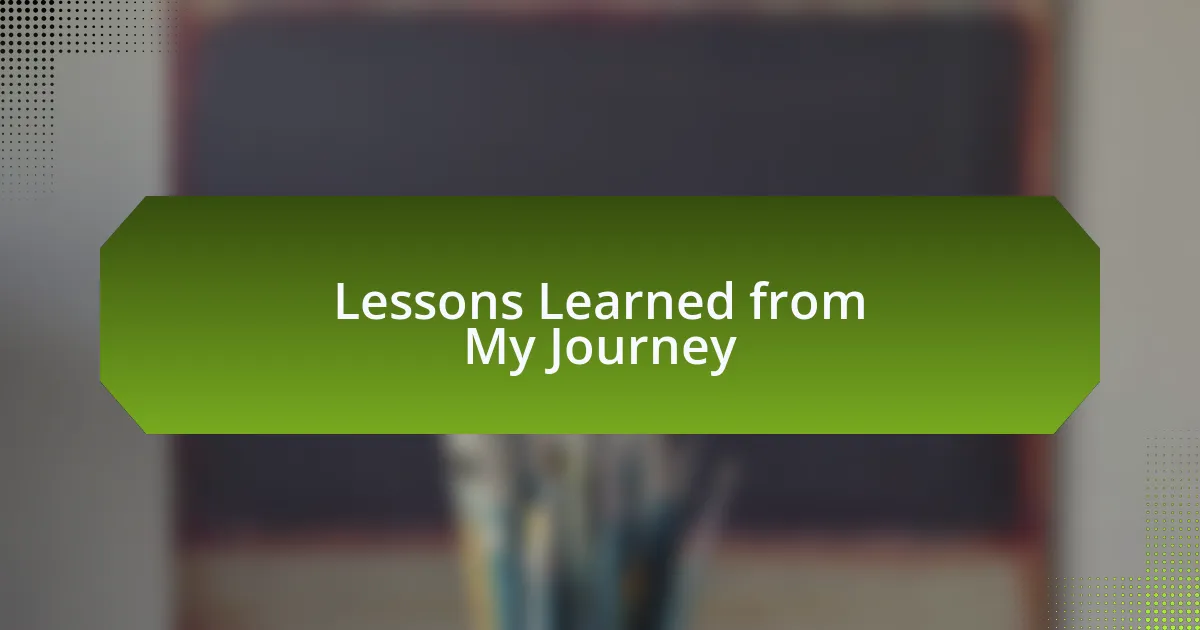
Lessons Learned from My Journey
In my journey into abstract expressionism, I’ve realized that vulnerability is an essential part of creativity. One day, while exploring a new color palette, I allowed myself to express feelings of sadness and joy on the canvas simultaneously. The emotional weight of that experience opened my eyes to the power of authenticity; creating art is most impactful when you let raw feelings flow without judgment. Have you ever felt liberated by being honest in your expression?
Another lesson emerged from my encounters with fellow artists. I remember attending a workshop where sharing our struggles and breakthroughs felt like uniting in a collective heartbeat of creativity. This camaraderie taught me that collaboration can breathe new life into my work, reminding me of the strength found in community. Why do we often hesitate to share our creative journeys with others when doing so can enrich our art?
Finally, I’ve come to appreciate the importance of patience in my artistic process. I recall a piece I labored over for weeks, only to realize it needed a drastic change. Instead of rushing, I stepped back and allowed my instincts to guide me. In this pause, I discovered that sometimes, the most profound transformations happen when we give ourselves permission to reflect and breathe. Isn’t it interesting how taking a step back can lead to a more vibrant push forward?